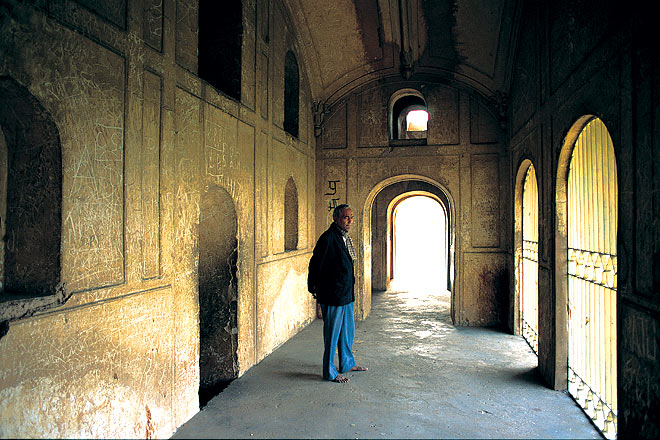“If cities were built by the sound of music, then some edifices would appear to be constructed
Even though it now seems dirty and democratic beyond repair, Lucknow must have been built like that. And it is a fortunate thing that cities once erected can never truly be destroyed, some edifice always remaining to affirm that there was a past, and it was more interesting.
The Bhul-Bhullaiyan or Labyrinth of Old Lucknow is in fact not an edifice in itself, but part of a much larger monument—the Asafi Imambara. This sprawling riverside magnificence took 15 years to finish, beginning A.D.1784 during the reign of Asaf-ud-daula, fourth Nawab of Awadh. As an architectural complex, the Imambara would fall squarely in the ‘dancing forth to light, fantastic airs’ category, starting at the ornate, half-Byzantine gate, if not for two exceptions that are of the other kind.
Besides the grave and solemn tones, there is also about these two features a most secret air, the Baoli or underground step-well reservoir being the less covert of the two. The second, and twice as hidden and mysterious, is the Bhul-Bhullaiyan. One of the very few rooftop labyrinths in the world, it extends to the right of a high staircase that ascends the left flank of the Imambara-proper, the staircase itself concealed behind an innocuous arched alcove in the extended gallery thereof—so innocuous that one would not expect such a thing from it, and might miss it entirely if not for the touts and the ASI.
Spread across the length of the actual Imambara’s roof, the strange asymmetric hive is laid out in three terraced floors, an entrance to each of which is provided on the right of the main staircase. The one at its apex opens onto the Bhul-Bhullaiyan’s expansive roof, lined on all sides with turrets and Turkish-looking cupolas. Two apertures are cut into the floor of the roof, and these are also doorways to the Labyrinth.
I remember when I first visited it back in my half-pant donning days, on a school Picnic. When our class had got to the lower staircase-side entrance, the Guide accompanying us asked very dramatically if any amongst our ranks believed they were clever enough to enter the maze and come out on their own. I ran straight into the low and narrow gallery, passing an ominous opening in the left wall and two skewed corridors that branch off from it, soon reaching the point where the gallery turns left. After taking five steps in that considerably darker direction, I turned and ran back out whooping manically. But to my surprise I was received coldly. I can still recall the Guide’s derisive laughter as he exclaimed, “Arre Mian! To have found your way out of a Bhul-Bhullaiyan, you must first be lost!”
This is easy enough, and accomplished no sooner than one has taken a couple of turns into the corridors or gone down one small flight of steps and up another, presenting an endless latticework of passages—well-lit, dim-lit and unlit— some of which lead without warning to dead-ends and precipitous drops. Others terminate at the Zenana balconies surrounding the main Hall, while the few that continue into the lower chambers of the Imambara are walled-up and said to lead to the curious tunnel-system beneath it that is out-of-bounds for the Public. Stories abound, perhaps only for the benefit of more macabre-minded tourists, about people who entered the tunnels either never to return or worse, to come back all old and rickety, way beyond their years.
The full extent and layout of the bhul bhullaiyan is unknown, but there is however an excellent tale explaining this lack of specific building information about the Labyrinth—the three greatest treasures of 19th-century India were those of Bengal, Awadh, and Hyderabad. Of these, the English got their hands on the first during the great famine, whereas the last, that of Hyderabad, was acquired by the Government of India sometime after 1947. But the Treasure of Awadh was never found. Legend has it that Qifayat-Ullah Shah Jehanabadi, who was the Asafi Imambara’s chief Architect, added the labyrinth to his building-plans on the express command of the Nawab, as the hiding place of this treasure. When the English came to effect their conquest of the province, the Wazir is said to have thrown himself into the Baoli, along with the plans and the keys to the Treasure. It is further said that four English divers followed him, but like the old Wazir, they too never surfaced again.
The Bhul Bhullaiya retains that air of intrigue, and being lost in time. If ever you feel disenchanted with the times, there really is no better place to visit than this Nacheez, this non-thing of no value.
City of Nawabs
Labyrinth
Lucknow
Leave a Reply
You must be logged in to post a comment.


